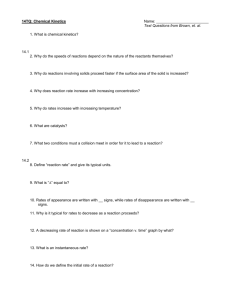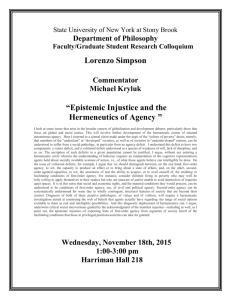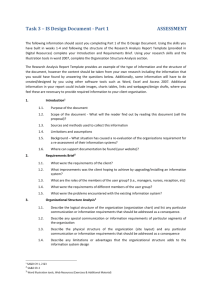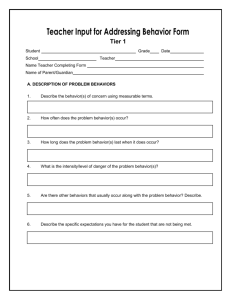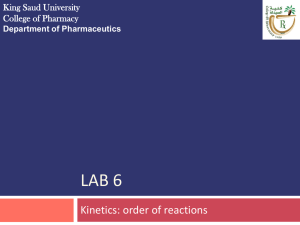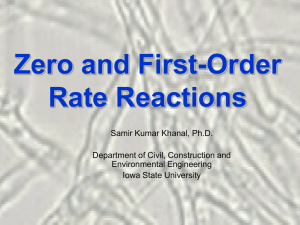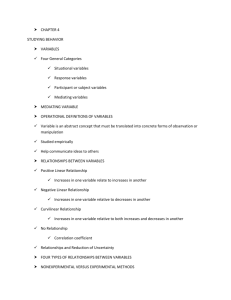First-order validity and consequence
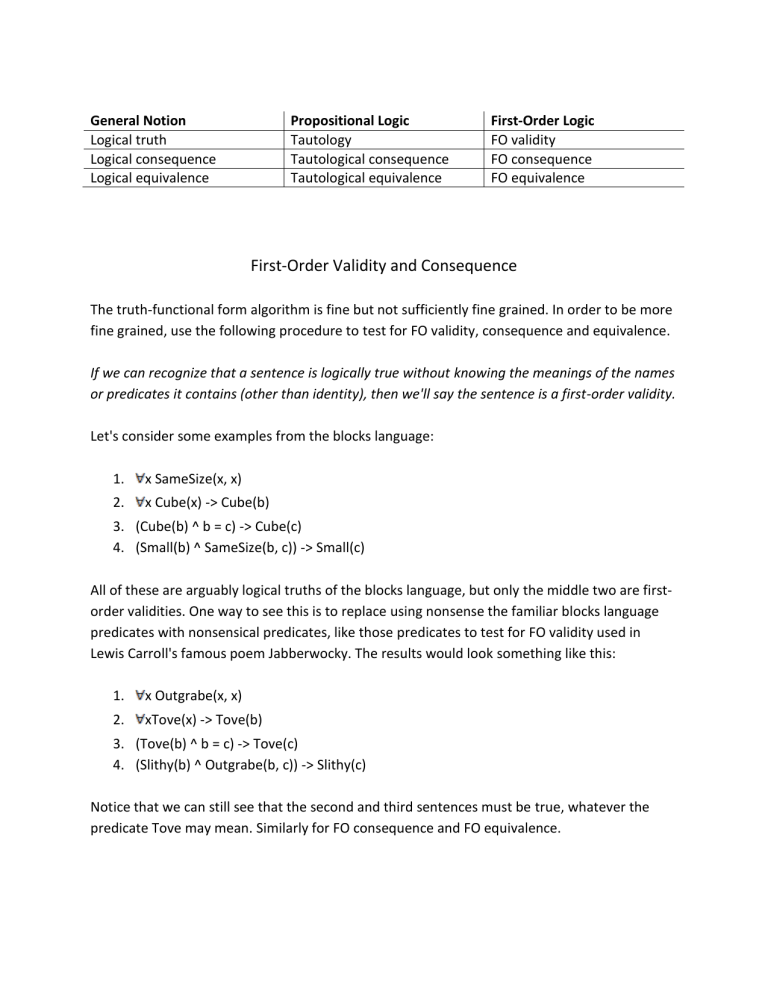
General Notion
Logical truth
Logical consequence
Logical equivalence
Propositional Logic
Tautology
Tautological consequence
Tautological equivalence
First-Order Logic
FO validity
FO consequence
FO equivalence
First-Order Validity and Consequence
The truth-functional form algorithm is fine but not sufficiently fine grained. In order to be more fine grained, use the following procedure to test for FO validity, consequence and equivalence.
If we can recognize that a sentence is logically true without knowing the meanings of the names or predicates it contains (other than identity), then we'll say the sentence is a first-order validity.
Let's consider some examples from the blocks language:
1.
x SameSize(x, x)
2.
x Cube(x) -> Cube(b)
3.
(Cube(b) ^ b = c) -> Cube(c)
4.
(Small(b) ^ SameSize(b, c)) -> Small(c)
All of these are arguably logical truths of the blocks language, but only the middle two are firstorder validities. One way to see this is to replace using nonsense the familiar blocks language predicates with nonsensical predicates, like those predicates to test for FO validity used in
Lewis Carroll's famous poem Jabberwocky. The results would look something like this:
1.
x Outgrabe(x, x)
2.
xTove(x) -> Tove(b)
3.
(Tove(b) ^ b = c) -> Tove(c)
4.
(Slithy(b) ^ Outgrabe(b, c)) -> Slithy(c)
Notice that we can still see that the second and third sentences must be true, whatever the predicate Tove may mean. Similarly for FO consequence and FO equivalence.
Some more examples: x (Tet(x) -> Large(x))
¬Large(b)
¬Tet(b)
This argument is obviously valid. What's more, if we replace the predicates Tet and Large with nonsense predicates, say Borogove and Mimsy, the result is the following: x (Borogove(x) -> Mimsy(x))
¬Mimsy(b)
¬Borogove(b)
FO Counterexamples
Consider the following set of sentences:
¬ x Larger(x, a)
¬ x Larger(b, x)
Larger(c, d)
Larger(a, b)
Is the conclusion a consequence? Is it a logical consequence?
¬ x Foo(x, a)
¬ x Foo(b, x)
Foo(c, d)
Foo(a, b)
Let a, b, c, d be assigned as above, and let “foo” be “likes”
Replacement Method
1.
To check for first-order validity or first-order consequence, systematically replace all of the predicates, other than identity, with new, meaningless predicate symbols, making sure that if a predicate appears more than once, you replace all instances of it with the same meaningless predicate. (If there are function symbols, replace these as well.)
2.
To see if S is a first-order validity, try to describe a circumstance, along with interpretations for the names, predicates, and functions in S, in which the sentence is false. If there is no such circumstance, the original sentence is a first-order validity.
3.
To see if S is a first-order consequence of P
1
,…, P n
, try to find a circumstance and interpretation in which S is false while P
1
,…,P n
are all true. If there is no such circumstance, the original inference counts as a first-order consequence.
Recognizing whether a sentence is a first-order validity, or a first-order consequence of some premises, is not as routine as with tautologies and tautological consequence.
With truth tables, there may be a lot of rows to check, but at least the number is finite and known in advance.
With first-order validity and consequence, the situation is much more complicated, since there are infinitely many possible circumstances that might be relevant. In fact, order validity there is no correct and mechanical procedure, like truth tables, that always answers the question is S a first-order validity?
Summary
1.
A sentence of FOL is a first-order validity if it is a logical truth when you ignore the meanings of the names, function symbols, and predicates other than the identity symbol.
2.
A sentence S is a first-order consequence of premises P
1
, …, P n
if it is a logical consequence of these premises when you ignore the meanings of the names, function symbols, and predicates other than identity.
3.
The Replacement Method is useful for determining whether a sentence is a first-order validity and whether the conclusion of an argument is a first-order consequence of the premises.
4.
All tautologies are first-order validities; all first-order validities are logical truths. Similarly for consequence.

